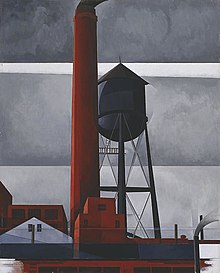Precisionism

The Precisionism (Engl. Precisionism ) was a style of American painting , which after the First World War came and in the interwar period peaked. Precisionism was part of American realism and was heavily influenced by cubism and futurism .
Motifs and style
Like other realists, the representatives of precisionism consciously set themselves apart from traditional landscape painting and historicizing, but also abstract art . The main motifs they chose were big cities, industrial complexes and other technical facilities. Since they worked with precise geometric shapes and perfect color gradients without impurities, they were also called Sterilists (Sterilists) and Immaculates (the flawless). The representations show a growing self-confidence in American industrial society and a certain admiration for its buildings, but social comment (unlike the Ashcan School ) was not a central element of precisionism.
Important representatives
Charles Demuth , Charles Sheeler, and Georgia O'Keeffe were important representatives of precisionism.
swell
- ↑ cf. The large art lexicon by PW Hartmann , accessed on July 8, 2007. And: Stefano Zuffi, picture atlas of painting . EA Seemann Verlag, Leipzig 2004.
Web links
- The Precisionist Art History Archive - an archive of images with works by precisionists and their associated artists; Charles Sheeler biography.
- Ten Dreams - picture gallery with works by Charles Sheeler.